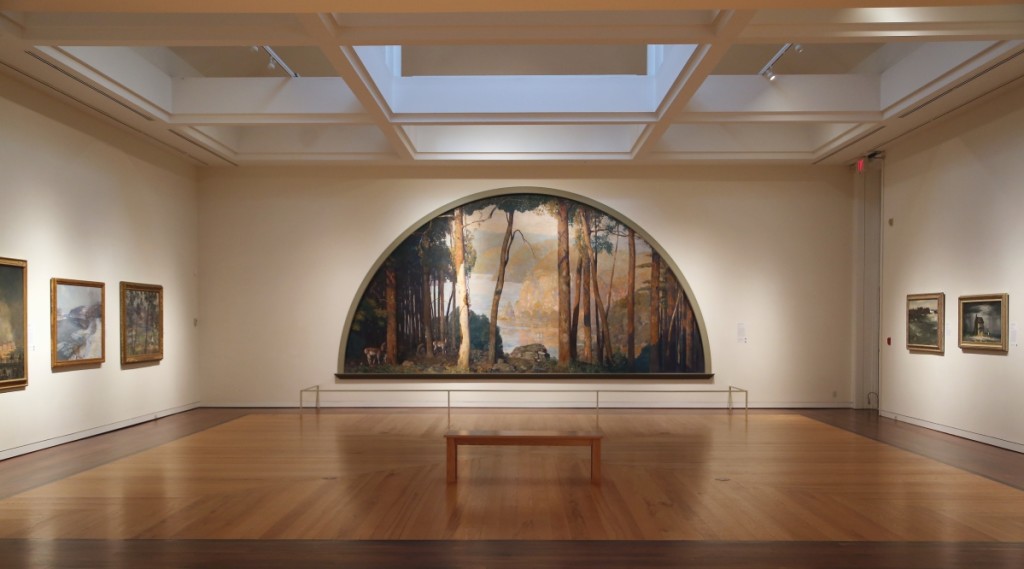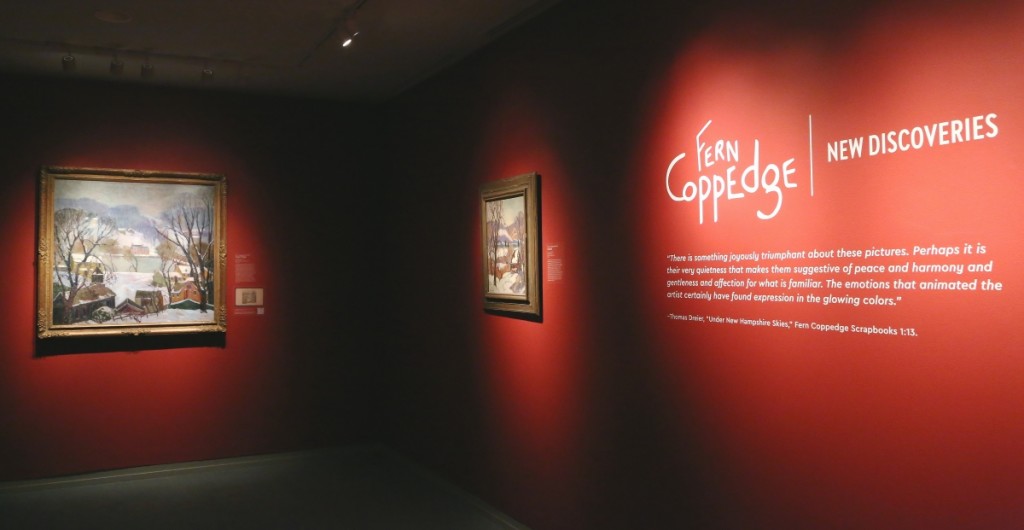
Daniel Garber’s “A Wooded Watershed” was originally commissioned for the 1926 Sesquicentennial Exhibition in Philadelphia. The view features the Delaware River Gap in its pristine form, without any human presence at all.
By Greg Smith
DOYLESTOWN, PENN. -Arriving in my inbox on a late Thursday September afternoon was an email from the James A. Michener Art Museum. A paragraph read: “The Michener is also introducing a new program called Private Eyes, offering the ability to rent the entire museum for two-hour bookings on Tuesdays and Wednesdays for those who are not ready for public settings.”
“The whole place all to yourself,” I mused, picturing the scene in Home Alone when Macaulay Culkin believes he disappeared his family and instantly becomes lord of the manor.
Almost every arts and cultural institution has suffered great loss in 2020 and forecasts the pain to continue into 2021. Nearly all have been affected by layoffs, programming shifts and apocalyptic attendance declines. They remain in a quasi-state of awake as they reach out to this paralyzed leisure economy, so much of their mission derived from interaction with the public – a public that is increasingly and statistically weary of entering enclosed public spaces.
As states separately wrangle with regulations surrounding the reopening of public buildings, the ticket reservation model has emerged ubiquitous among museums, allowing these places to manage the inflow of people through their doors.

The James A. Michener Art Museum boasts 15,000 square feet of gallery space housed in the original Bucks County prison.
The Michener currently caps general admission to 120 at any one time, a more conservative number than the State of Pennsylvania’s current guidelines allow them to have.
This kind of environment breeds both leeway and creativity. Strings that were once taut have been loosened, like how the Michener can allocate tickets to certain time slots and withdraw them from others if they choose. There’s no apologizing. “These are weird times,” people nod and repeat, over and over.
That leeway allows for an early opening on Sunday exclusive to museum members as well as slots on both Tuesdays and Wednesdays where anyone with $600 can rent the entire museum for two hours (or $500 for members – psst, basic membership is $50, wink wink). The museum is closed to the public on Monday, Tuesday and Wednesday.
“Private Eyes offers you and your quarantine bubble the opportunity to stroll our safe and clean galleries in isolation,” said the Michener’s executive director Kate Quinn.
Isolation, intimacy, individual.
In the run up to my reservation at the Michener, my first consideration was how many people I would bring. You can bring up to 25 people.
I chose none. I was to be the only one there. The king of the apparent castle whose tall stone walls were built in 1884 to keep people both in and out – at the judge’s discretion – as the Bucks County prison. Maybe not the king, but the warden?
I anticipated a great quiet, more than museums usually are. Not even the footsteps of another visitor. Not their whispers or their thoughts floating around me. Not even from six, ten or 30 feet away.
Others who take part in the program would be different. I see corporate events, employers who want to give their employees a little respite from the last few months. Sara in accounting looks at her colleague Rachel as they stand apart in front of a snow-swept Fern Coppedge painting in the museum’s special exhibition on four recent acquisitions of the artist’s work. “My mom had one that looked just like that in her living room,” she’d say. Rachel would laugh. They’d move on.
I also see a family: the kids screaming in the high-ceiling rooms, their voices echoing off the paintings. No one to bother, no one to tell them to quiet down. Scream as loud as you want.

Phillip Lloyd Powell’s carved and polychromed door and surround is among the finest pieces of design in the museum’s collection. Curators wrote that Powell was likely inspired by Moorish horseshoe arches that he saw while traveling in Spain and Morocco.
I see an elderly couple who, having spent a lifetime appreciating art, haven’t been to a single exhibition in half a year because they are immunocompromised. They sit on a bench and take out sandwiches from the museum’s café in front of Daniel Garber’s 22-foot-wide “A Wooded Watershed,” and proceed to get lost in the forest and each other.
I see any arts, social or educational group dropping in for a field trip – the first one in ages.
I asked the internet what they would do with their two hours. One person said, “go home, museums aren’t fun without family or friends.” Some said they would nap in a gallery. Another suggested a heist.
Useless, except for the last one. That was fun to think about.
As I arrived, the only intention I had was to listen.
Inside the Putnam | Smith Gallery, the Michener houses its best collection: that of the Pennsylvania Impressionists. Harry Leith-Ross, George Sotter, John Folinsbee, Edward Redfield, Rae Sloan Bredin, M. Elizabeth Price, the aforementioned Coppedge and Garber.

Left, “Woodside Park” by Frederick R. Wagner (1860-1940). Right, “The Horse with the Lavender Eye” by Paulette Van Roekens (1896-1988).
Their paintings, in the context of my viewing them in that moment, represented the crossroads of intimacy and isolation. You could look at six or seven paintings before you saw a soul painted inside them. Instead these artists relished the untouched countryside, the rural life, the quiet.
The room was silent.
I drifted into the boutique Coppedge show. You can’t help but envision Fern outside after a bluster trudging through knee-high snow until she found a vista suitable to her eye. The paintings reminded me of my least favorite season coming down the pipe, though I wondered if she would have been disappointed in 2020, too. I only shoveled my driveway in Connecticut three times last winter.
That led me both figuratively and directly – the doorways adjoin – into the museum’s latest special exhibition titled “Rising Tides: Contemporary Art and the Ecology of Water,” which showcases seven contemporary artists whose works illustrate the effects of global warming, climate change, pollution and related environmental concerns on bodies of water and aquatic species.
There is again a calm to this room, focused by the looped recordings of whale calls and lapping tides from Marguerita Hagan’s “Interdependence,” a monumental wall installation that combines ceramic sculptures in the form of sea creatures with video projection and sound. Paula Winokur’s porcelain sculptures in “Shattered Ice” appear as large shards that have broken and fractured away from a greater whole.

Four new acquisitions of work by Bucks County artist Fern Coppedge (1883-1951) receive the special treatment. The show includes a selection of the artist’s scrapbooks and continues through April 21.
Inside the Commonwealth Gallery, Modern works bring us back to the idea of intimacy. Kenneth Hayes Miller’s “After Dinner Music” features an endearing living room scene where a father plays piano, the mother sings and their daughter watches on with rapt attention. Paulette Van Roekens’ “The Horse With The Lavender Eye” settles on a scene of great joy on a carousel ride. Two adult women sit together in a seat, one seemingly laughing with her neck turned up, while a little girl rides a steed beside them, her white skirt blowing off the side of the horse from the inertia. These small moments are everywhere.
My time is winding down as I get back in front of the Pennsylvania Impressionists and settle on Edward Redfield’s “The Burning of Center Bridge.” Center Bridge was built in 1812 to connect New Jersey and Pennsylvania, and was at one time the oldest structure on the Delaware River. Lightning struck the wooden bridge in 1923, engulfing it in flames and leaving behind nothing but its stone piers. Redfield lived north of the bridge and arrived to paint a scene whose sole light comes from the embers of disaster. Every figure in the work’s foreground a black silhouette or sometimes a shade of red, the reflection of the glowing light of the great fire on their life. It was, as you can imagine, a commercial fiasco, one that would change the routes of commerce in the surrounding area.
The routes of commerce have certainly burned, bent and twisted in the past few months. For those with feet on the ground, the unsettling dawn has already given way to a rebuilding of sorts. A sense of pragmatism and creativity that hopes to bridge the gap, much like folks did when the Center Bridge burned and its replacement took three years to arrive.
The Michener is one of many small regional museums who stare across a chasm and prepare a way to make it to the other side. Its look towards intimacy is timely and wise.
The good news is that the Center Bridge, its steel replacement, still stands – now engineered to last a few lifetimes and more. People drive over it every day. It makes you wonder if these initiatives, these micro experiences, while seemingly necessary in the moment, have a place in the future as well.















